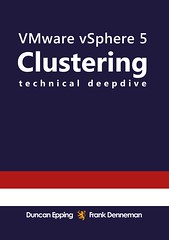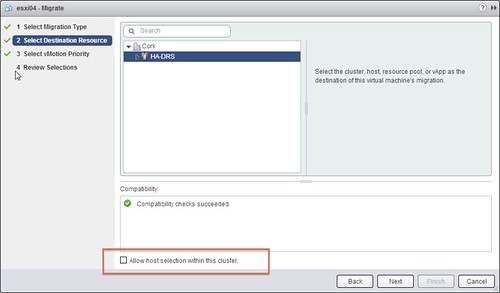In vSphere 5.5 a couple of new pieces of functionality have been added to DRS. The first one is around the maximum number of VMs on a single host that DRS should allow. I guess some of you will say hey didn’t we introduce that last year with that advanced setting called “LimitVMsPerESXHost“? Yes that is correct, but the DRS team found this too restrictive. They’ve added an extra setting which is called LimitVMsPerESXHostPercent. A bit smarter, and less restrictive… so how does it work?
Basically LimitVMsPerESXHostPercent is LimitVMsPerESXHost in a more dynamic way as it automatically adjusts the limits. When you set LimitVMsPerESXHostPercent to 50 in a 4 host cluster which is running 20 VMs already and you want to poweron 12 new VMs. How many VMs can a single host run?
32 total VMs, 4 hosts --> mean: 8 VMs per host
We set the percentage to 50 so the new limit is 8 + (50% * 8) = 12
So if host 1 was only running 2 VMs, it can now take on an additional 12 without the need for you to constantly change the LimitVMsPerESXHost when you introduce new VMs. LimitVMsPerESXHostPercent does this for you.
Latency Sensitive Workloads
As of vSphere 5.5 DRS recognizes VMs marked as latency-sensitive (vCenter Web Client option). With 5.1 it could occur that latency sensitive VMs were moved around by DRS, as you can imagine when a VM migrates this will impact which ever application is running. Although the impact is typically little, for a latency sensitive workload even “little” could be disastrous. So in order to avoid this unwanted impact DRS treats latency sensitive VMs as if they have soft-affinity to the host they are running on. But what when there is an absolute need to migrate this VM, well as mentioned it is “soft affinity”, so treated like a “should rule” and in that case it means that the VM can be moved when needed.
Do note that within the DRS UI you don’t see this affinity anywhere, this is solved within DRS itself. Awesome and needed if you ask me!
Another one
Last but not least another new advanced option, this option is titled “AggressiveCPUActive“. When you set it to “1” DRS will be more aggressive when it comes to balancing VMs when %RDY is impacting them. This can be useful in environments where %RDY has a very spiky behaviour. AggressiveCPUActive will help avoid averaging out the bursts and will allow for DRS to aggressively balance your virtual infrastructure. (Official explanation: AggressiveCPUActive, when set to 1, causes DRS to use the 80th percentile of the last five 1-minute average values of CPU activity (in other words, the second highest) to predict the CPU demand of virtual machines in the DRS cluster, instead of using the 5-minute average value (which is the default behavior). This more aggressive DRS behavior can better detect spikes in CPU ready time and thus better predict CPU demand in some deployments.)
DISCLAIMER: I do not recommend using advanced settings unless there is an absolute need for it. I can see why you would use the “LimitVMsPerESXHostPercent” but be careful with “AggressiveCPUActive“.


